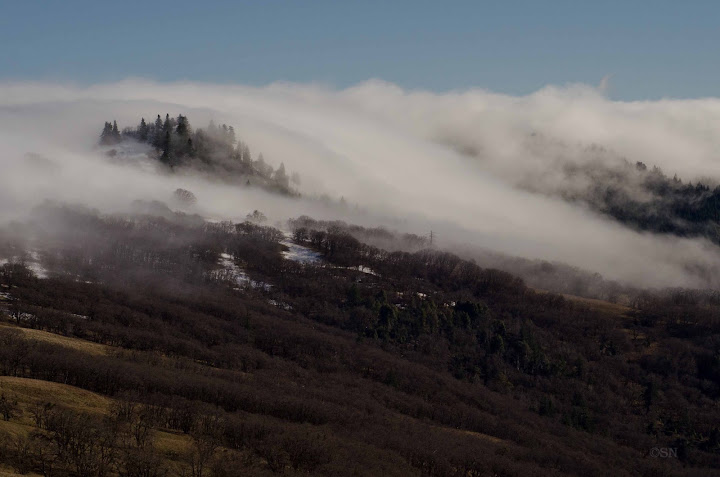As is human nature, people are naturally attracted to peaks. Whether it’s for the good views to survey, a place for reflection, or the chance to add another check mark of accomplishment, peaks and high places have been sought out for thousands of years. The peaks around these parts of Northern California [more specifically North Coast California], while not high enough to make the ‘best of’ lists, offer lovely views of rolling mountain ranges, the recalcitrant Pacific Ocean, plus a few hidden surprises.

A surreal scene at the top of Horse Mountain looking down to the Pacific Ocean
The first surprise probably isn’t that fascinating to most, save a few renaissance, jack-of-all-trades types, but it is certainly surprising. I found out about it this way: sitting in the visitor center the other day, an older lady came to the desk searching for some type of mine or quarry. While the existence of such a thing within park boundaries seems feasible, especially considering how young the park is, neither my co-ranger nor I really knew much about it [not to mention, disturbing the ground within park boundaries opens no fewer than 3 cans of worms, proverbially speaking]. Turns out, the peak is just outside the park boundary [not sure about the quarry areas though], but the minerals discovered almost 30 years ago are decently rare and new: Coyoteite, named after the peak, and Orickite, whose namesake is the little hub of Orick. Huh!

The view from School House Peak to Coyote Peak
Speaking of things rare, another peak to the south offers some interesting treasures along the same vein. Horse Mountain lies 30 miles from the Pacific, more or less east of Eureka, California, and as one drives up Highway 299 to the peak, a change in vegetation occurs, so much so that Horse Mountain boasts a federal Botanical Area designation. This change is more than just a switch from coastal Sitka spruce that hugs the rocky shore to the redwood and Douglas-fir forests of the gently rolling Coastal Range. The change indeed occurs as the elevation increases, but Horse Mountain is around 4,000 ft–not enough to be alpine or even subalpine, so the difference found on the peak isn’t caused by elevation, nor even climate, alone. This peak has reached through some threshold that the surrounding land couldn’t.
As if using a magnifying glass to view the globe, a look at ecoregion [think: bigger than ecosystem] maps offers clues once the finest detailed “level 4” map is consulted. Starting at the grossest view and working down to the finest, the levels start at the Northwestern Forested Mountains of the Marine West Coast Forest, then down to the more specific Klamath Mountains/California High North Coast Range with the Horse Mountain area specifically falling in the Coast Range of that category.
These mouthful of words loosely state that Horse Mountain falls just on the border of the Pacific Northwest rainforest type of environment we often think of in coastal Washington and Oregon and the forested mountains of the Rockies. And the Coast Range category points directly at this region in California, but does not define what exactly makes Horse Mountain worthy of a botanical area designation compared to the rest of the Coast Range.

The “level 4” map unassumingly calls the area the “Western Klamath Montane Forest”, which does not relate the isolation and uniqueness of this area unless you consult the map and see the isolated dot south of the rest of the occurrence of this region.

A variety of conifers on the edge of Horse Mountain
The designation fails to mention the serpentine soils that sculpt the plant communities and had previously supported a mining operation at the peak. Serpentine isn’t a friendly rock, so thank heavens it’s not more common, otherwise plants would be faced with finding special methods to grow in a hostile environment full of toxic metals. It would be like us trying to live in a house full of carbon monoxide. We’d have to divert energy from developing and growing into coping with the adverse environment. So instead of looking at Facebook, you’d have to spend that time maintaining your breathing unit so you could continue to live in your oxygen deprived world. That’s what the plant community at Horse Mountain is doing. The area receives around the same amount of precipitation as the wet town of Eureka [somewhere around 50 some inches], but the plant community acts like it’s struggling against a lack of water. Among some of the intriguing species, Jeffery Pine, more at home in the Sierras, and Hoary Manzanita, whose family really likes chaparral areas [with frequent fires and 15-39 inches of rain], both call Horse Mountain, and all its precipitation, home thanks to some heavy metal, low nutrient dirt.
As interesting as peaks are to the human mind, the peaks of California’s North Coast are like the spires of a royal crown, each boasting natural jewels at the top worthy of being investigated thoroughly. While not every region in this country can point to peaks as their crown jewels, it’s a good bet that each nook and cranky has something unique to only that region nearby. Check out the Level IV Ecoregions map [large PDF–takes a while] and see what’s nearby your home!



















